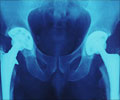
RA is a chronic, inflammatory, autoimmune disease that affects approximately 1 in 100 worldwide. It can cause pain, stiffness, joint destruction and deformity, and reduce quality of life, life expectancy and physical function.
"Radiographic damage is directly correlated to functional disability, overall severity and pain in patients with RA. At present radiographic damage of large joints is commonly evaluated by Larsen grade, which has severe limitations, including a ceiling effect within the grade," commented the study's lead author Dr. Isao Matsushita, Department of Orthopaedic Surgery, Faculty of Medicine, University of Toyama. "These data highlight the need for better scoring and evaluation, without which, progression of damage and patient needs cannot be accurately assessed."
Fifty one patients with a mean age of 59.9 years old were enrolled in the study; each fulfilled the ACR 1987 revised criteria*. Those with a history of surgical intervention were excluded from analysis. Radiographic findings were evaluated at baseline using the ARASHI status score, and at one and two years after TNF-blocking therapies (infliximab, etanercept or adalimumab) using the ARASHI change score.
ARASHI status score consists of 4 categories; joint space narrowing (0-3 points), erosion (0-3 points), joint surface (0-6 points), and stability (0-4 points), (total score range 0-16). ARASHI change score consists of 5 categories; porosis (-1-1 point), joint space narrowing (-1-2 points), erosion (-2-2 points), joint surface (-6-6 points), and stability (-1-1 point), (total score range -11-12). An increase in more than 1 point of change score was considered as progression of joint damage. "Patients with pre-existing damage demonstrated significant increases in the ARASHI change score during two-years of TNF-blocking therapy; highlighting progressive destruction even under drug therapy. These data show that joints are best protected with early and accurate evaluation, to ensure they do not exceed an ARASHI score of two, prior to the start of drug treatment," concluded Dr. Isao Matsushita.
Advertisement














